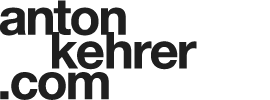 |
 |
||
| news about works projects bio texts media downloads contact deutsch english color, surface, light, popular culture and democratization franz thalmair the sum of light margit zuckriegl image processes and work opportunities martin hochleitner
|
/color, surface, light, popular culture and democratization When the camera is loaded with film and ready to take 37 pictures, the first shot usually represents the starting point for the rest of the work on that film. For every light object shot by Linz artist Anton Kehrer, there is at least one roll; there are no mixed films. The contact print is a central reference point in his striking works, because it is only the sprocket holes, the numbering and coding at the edges that reveal the medium used: analog photography, pushed to its limits and beyond. In contrast to its traditional application, the contact print here does not serve solely as a means to select individual images for processing and Diasec mounting behind glass in his series of photos, which bears the similarly serial title Lightflow. He also uses them as a gestural reference to the basis for his work, which reflects on the media. For without the contact sheet, which he always presents alongside the installational arrangements of his large format color surfaces, it might seem at first glance that these images were silk screens, digitally crafted visual worlds created on a computer, or even paintings. Anton Kehrer’s intermedia approach to photography, which within his own artistic development feeds on graphite works on paper, is clear from Lightflow_Move (2007). As a starting point for the two-part installation, which is instantly reminiscent of Mark Rothko's color field paintings, the artist makes use of a magenta-colored illuminated advertisement from the T-Mobile shop on Berlin’s Kurfürstendamm: quite banal, profane. Though Kehrer works with the camera, the process of photography is in his case more painterly than photographic in terms of its motivation. Sometimes he approaches the object to within a few centimeters; or he places the lens directly on the light source. Not least because of the camera’s inability to focus, monochrome areas of color develop, transitions, areas of running, artificial horizons, and seemingly spatial cones of light. Lightflow_Move (2007) represents an attempt to push the photographic process further towards painting by continuing to move the camera as the shot is taken. Kehrer’s reflections on familiar formal categories such as color, surface, light, as well as on the brushstroke are subject again and again to a rupture. It seems as though the artist does not want to enter the debate about media specificity and purism, lead so vehemently by Clement Greenberg. Indeed: the layering of photography, graphic art, and painting, as well as the recurring references to popular culture and the everyday even forbid thinking in these terms. “For me, it is futile to continue travelling the same course with the same techniques used by modernist painting,” the artist said in an interview. Furthermore, “I value many of these positions, and they serve me as a formal system of reference. In terms of visual effect alone, the abstract expressionists, above all Minimal Art from the United States, could be linked to my work, but not, however, in terms of content. This represents the decisive difference.” The break with art history that Kehrer constantly adopts in his works comes on the one hand from his choice of photographic subjects, and on the other from the homogenization of their contexts. As a template for the three-part installation Lightflow_Space (2003), he used a light installation by Keith Sonnier, which he had photographed at the art fair in Zurich. As inspiration for Lightflow_Monochromes (Black & Blue) (2006), however, he used an illuminated road sign that directed car drivers to a parking lot on the Boulevard de la Croisette in Cannes. Whether works by Dan Flavin, James Turrell, or Angela Bulloch or “merely” a petrol station roof, a beauty salon, or the Tarantula Bar on the Wiener Gürtel are ultimately at issue is not the point. Once again, this is entirely banal, profane: the motivation is the leveling of contents and the democratization of human perception of light and color. For his current work series Lightflow_Colored Glass (from 2008 onwards), derived from large-scale public sculptures such as Colored Sky (2007), Anton Kehrer is working in the studio. The artist mixes colored pieces of glass on a light table, as though on a palette, arranging them repeatedly, placing them on top of one another, thereby attaining a series color mixes and then, using the camera, he finally pushes painting to its limits—and beyond them. |
||